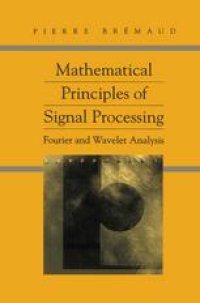
Ebook: Mathematical Principles of Signal Processing: Fourier and Wavelet Analysis
Author: Pierre Brémaud (auth.)
- Tags: Analysis, Signal Image and Speech Processing, Electrical Engineering, Fourier Analysis, Statistics for Engineering Physics Computer Science Chemistry and Earth Sciences, Complexity
- Year: 2002
- Publisher: Springer-Verlag New York
- Edition: 1
- Language: English
- pdf
Fourier analysis is one of the most useful tools in many applied sciences. The recent developments of wavelet analysis indicates that in spite of its long history and well-established applications, the field is still one of active research.
This text bridges the gap between engineering and mathematics, providing a rigorously mathematical introduction of Fourier analysis, wavelet analysis and related mathematical methods, while emphasizing their uses in signal processing and other applications in communications engineering. The interplay between Fourier series and Fourier transforms is at the heart of signal processing, which is couched most naturally in terms of the Dirac delta function and Lebesgue integrals.
The exposition is organized into four parts. The first is a discussion of one-dimensional Fourier theory, including the classical results on convergence and the Poisson sum formula. The second part is devoted to the mathematical foundations of signal processing - sampling, filtering, digital signal processing. Fourier analysis in Hilbert spaces is the focus of the third part, and the last part provides an introduction to wavelet analysis, time-frequency issues, and multiresolution analysis. An appendix provides the necessary background on Lebesgue integrals.
Fourier analysis is one of the most useful tools in many applied sciences. The recent developments of wavelet analysis indicates that in spite of its long history and well-established applications, the field is still one of active research.
This text bridges the gap between engineering and mathematics, providing a rigorously mathematical introduction of Fourier analysis, wavelet analysis and related mathematical methods, while emphasizing their uses in signal processing and other applications in communications engineering. The interplay between Fourier series and Fourier transforms is at the heart of signal processing, which is couched most naturally in terms of the Dirac delta function and Lebesgue integrals.
The exposition is organized into four parts. The first is a discussion of one-dimensional Fourier theory, including the classical results on convergence and the Poisson sum formula. The second part is devoted to the mathematical foundations of signal processing - sampling, filtering, digital signal processing. Fourier analysis in Hilbert spaces is the focus of the third part, and the last part provides an introduction to wavelet analysis, time-frequency issues, and multiresolution analysis. An appendix provides the necessary background on Lebesgue integrals.
Fourier analysis is one of the most useful tools in many applied sciences. The recent developments of wavelet analysis indicates that in spite of its long history and well-established applications, the field is still one of active research.
This text bridges the gap between engineering and mathematics, providing a rigorously mathematical introduction of Fourier analysis, wavelet analysis and related mathematical methods, while emphasizing their uses in signal processing and other applications in communications engineering. The interplay between Fourier series and Fourier transforms is at the heart of signal processing, which is couched most naturally in terms of the Dirac delta function and Lebesgue integrals.
The exposition is organized into four parts. The first is a discussion of one-dimensional Fourier theory, including the classical results on convergence and the Poisson sum formula. The second part is devoted to the mathematical foundations of signal processing - sampling, filtering, digital signal processing. Fourier analysis in Hilbert spaces is the focus of the third part, and the last part provides an introduction to wavelet analysis, time-frequency issues, and multiresolution analysis. An appendix provides the necessary background on Lebesgue integrals.
Content:
Front Matter....Pages i-xii
Front Matter....Pages 1-5
Fourier Transforms of Stable Signals....Pages 7-22
Fourier Series of Locally Stable Periodic Signals....Pages 23-30
Pointwise Convergence of Fourier Series....Pages 31-47
Front Matter....Pages 49-54
Filtering....Pages 55-73
Sampling....Pages 75-93
Digital Signal Processing....Pages 95-113
Subband Coding....Pages 115-126
Front Matter....Pages 127-132
Hilbert Spaces....Pages 133-144
Complete Orthonormal Systems....Pages 145-154
Fourier Transforms of Finite Energy Signals....Pages 155-160
Fourier Series of Finite Power Periodic Signals....Pages 161-166
Front Matter....Pages 167-173
The Windowed Fourier Transform....Pages 175-183
The Wavelet Transform....Pages 185-194
Wavelet Orthonormal Expansions....Pages 195-215
Construction of an MRA....Pages 217-227
Smooth Multiresolution Analysis....Pages 229-237
Back Matter....Pages 239-269
Fourier analysis is one of the most useful tools in many applied sciences. The recent developments of wavelet analysis indicates that in spite of its long history and well-established applications, the field is still one of active research.
This text bridges the gap between engineering and mathematics, providing a rigorously mathematical introduction of Fourier analysis, wavelet analysis and related mathematical methods, while emphasizing their uses in signal processing and other applications in communications engineering. The interplay between Fourier series and Fourier transforms is at the heart of signal processing, which is couched most naturally in terms of the Dirac delta function and Lebesgue integrals.
The exposition is organized into four parts. The first is a discussion of one-dimensional Fourier theory, including the classical results on convergence and the Poisson sum formula. The second part is devoted to the mathematical foundations of signal processing - sampling, filtering, digital signal processing. Fourier analysis in Hilbert spaces is the focus of the third part, and the last part provides an introduction to wavelet analysis, time-frequency issues, and multiresolution analysis. An appendix provides the necessary background on Lebesgue integrals.
Content:
Front Matter....Pages i-xii
Front Matter....Pages 1-5
Fourier Transforms of Stable Signals....Pages 7-22
Fourier Series of Locally Stable Periodic Signals....Pages 23-30
Pointwise Convergence of Fourier Series....Pages 31-47
Front Matter....Pages 49-54
Filtering....Pages 55-73
Sampling....Pages 75-93
Digital Signal Processing....Pages 95-113
Subband Coding....Pages 115-126
Front Matter....Pages 127-132
Hilbert Spaces....Pages 133-144
Complete Orthonormal Systems....Pages 145-154
Fourier Transforms of Finite Energy Signals....Pages 155-160
Fourier Series of Finite Power Periodic Signals....Pages 161-166
Front Matter....Pages 167-173
The Windowed Fourier Transform....Pages 175-183
The Wavelet Transform....Pages 185-194
Wavelet Orthonormal Expansions....Pages 195-215
Construction of an MRA....Pages 217-227
Smooth Multiresolution Analysis....Pages 229-237
Back Matter....Pages 239-269
....